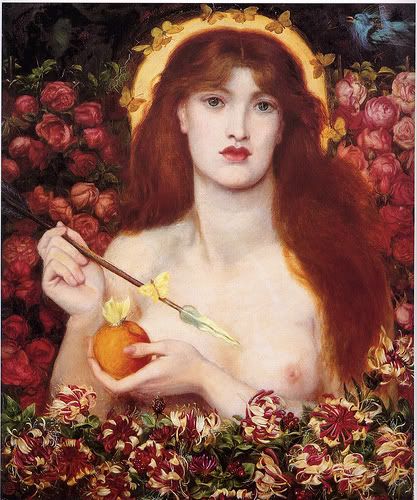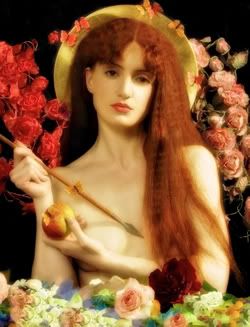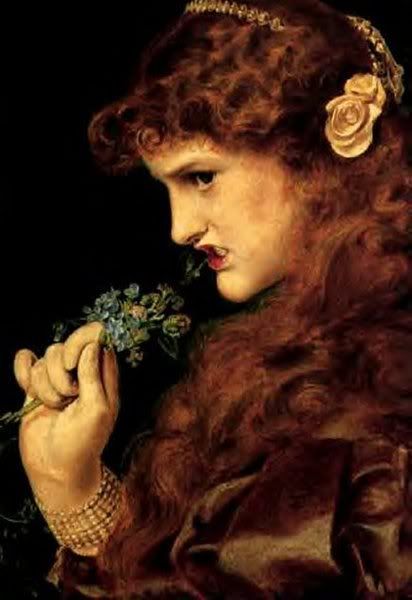Photographer John Knight has a passion for the Pre-Raphaelites (and for vintage and fine art photography in general). Knight's specialty is the Art Deco period (his studio is actually called Art Deco Studio), but he began his work recreating Pre-Raphaelite images after using two models he felt strongly resembled Jane Morris and Lizzie Siddal. Since then, Knight has recreated a number of iconic Pre-Raphaelite images for modern audiences. 
And here we have John Knight's photographic interpretation of the painting: 
Of course, Knight uses a great deal of image editing software in order to reproduce the paintings, but it would be impossible to make them look much like the originals without it.
His interpretation of Frederick Sandy's "Love's Shadow" is spectacular, though it shies away from the energy and anger of the original. The girl in Knight's version is a quite a bit more coy and far less threatening than Sandys' (who you will recall is actually baring her teeth in the painting).
Knight's version: 
Anthony Frederick Sandys' version - teeth bared, and looking a bit vicious: 
I asked Knight what drew him to Pre-Raphaelite art. He replied that
"the images created by the PRB are amongst the most enduring of all art works ever created. They touch the soul and the heart, they challenge the eye and they transport the viewer back...back to fantasy, to chivalry, to folklore and myth to the stories of our childhood and the dreams of our imagination."
I couldn't agree more!
Be sure to check out John Knight's website for more of his Pre-Raphaelite images. Many are quite extraordinary--I think my favourites are the Venus Verticordia (shown above) and Flaming June.


6 comments:
Such a wonderful idea.
Okay, maybe I'm just biased or imagining things, but the new ones, decidedly modern, look too posed and enhanced for effect. The first original appears caught mid-gaze, while the other seems more studied, like a photo shoot. The Sandy original is full of life and energy, actual anger--you feel like you understand her intensity--like there must be some reason. The copy is sort of green Goth girl, and looks a lot like some girls in my classes at Evergreen! Maybe that is the intention--probably it is--a modern take on "it" girls of yesterday. But I find it creepy, like the photographic realism of some children's book art--just a little too fascinated with photographic effects--like a forensic study.
I'm all for this type of reproduction but here unfortunately I have to agree with the above. It doesn't really work.
Very pretty effects... quite magical really. I'm all for the realm of fantasy and imagination!
Love your blog
I just launched an Art Social-networking website called ArtSavvy.com. If you have time to check it out I'd love to hear your feedback (Kyle@ArtSavvy.com).
Just saw your tweet about baby einsteins. The literature on the topic will tell you that a child should not be exposed to television until after two years old. The theory is that all those flickering images mess up the pathway formation in brain development. One researcher actually found a higher incidence of ADHD in children who watched Baby Einsteins in particular.
My personal belief: keep the tv off around them until they're two, and then give them sesame street and other well-researched educational programs. Keep poorly researched shows like Dora the Explorer out of the home (after watching episode after episode I'm fairly certain that their objective for each episode is not uniformely met, the Spanish often seems incorrect and is not taught by a native speaker, and the topics are not developmentally appropriate for the target audience).
Now that's out of the way: I'm never quite sure how I feel about photographic renderings of paintings. They seem more novelty than art. We'll stop and say "oh hey, they re-created the dogs playing poker!" but will we find artistic value in it (apart from its soaring fame, does Dogs Playing Poker have a ton of artistic value?)? Of course that harkens back to the first rule: Art is subjective.
Post a Comment